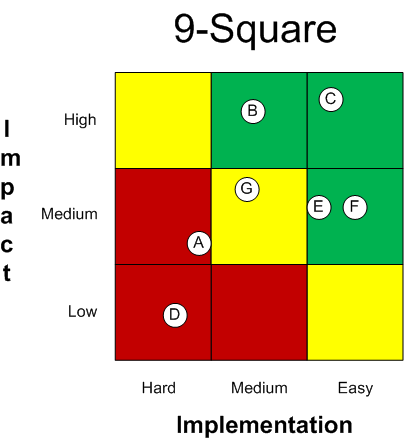9-Square (Prioritization Tool)
The 9-square is a prioritization tool in Lean problem solving that helps you organize your improvement ideas. After completing a brainstorming session in which you compile a large number of viable options, you have to decide which ones to implement. To use the 9-square, rank each problem in two categories: impact and ease of implementation.
Create a 3 x 3 grid, with low, medium, and high impact as the vertical scale. Hard, medium, and easy to implement go on the horizontal scale. Place your options into the appropriate boxes. At this point, there may be little hard information, but you should be able to make an educated guess as to which square each idea should fall into.

The 9-square gives a visual representation of where projects fall relative to each other. I normally code each idea with a letter and write the corresponding letters on the grid—otherwise in a big project the 9-square quickly becomes cluttered. Alternately, I use a large grid on the wall and place sticky notes in the appropriate location. You end up with something like this example.

In some cases, the decision of which idea to try is not perfectly clear. You might have to choose between two similarly valued proposals. For example, would you rather do a medium impact, but easy project (F), or a high impact project that will require medium effort (B)? You will run into a few of these situations, but generally, you’ll end up with the most desirable project being at the top right, and the worst options at the lower left.
In this example, determining the sequence (except for the second and third spot) is a rather easy task. For the ones that are not crystal clear, you can always do a little research, or you can just pick one. The cost of getting the perfect answer might actually outweigh the difference in the benefit between the two choices.
Remember, though, this is a very, very rough prioritization tool. It is based on educated guesses and assumptions, so it should only be used in low-risk or low-cost situation. Don’t choose a new ERP using a 9-square. You can, however, pick between a few locations for a parts rack, or from among several ideas on how to improve phone service in a small call center. When the stakes are higher, you need a tool that is more data driven.


0 Comments